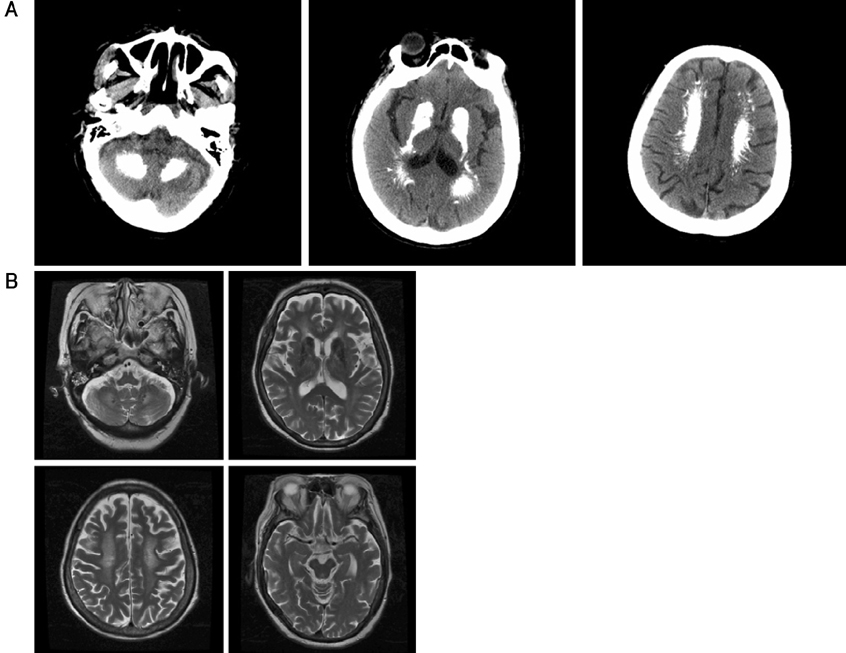J Clin Neurol.
2007 Mar;3(1):57-61. 10.3988/jcn.2007.3.1.57.
Striopallidodentate Calcification and Progressive Supranuclear Palsy-Like Phenotype in a Patient with Idiopathic Hypoparathyroidism
- Affiliations
-
- 1Department of Neurology, The Catholic University of Korea, Seoul, Korea. neuronet@catholic.ac.kr
- KMID: 1700689
- DOI: http://doi.org/10.3988/jcn.2007.3.1.57
Abstract
- We present a 77-year-old woman with levodopa-nonresponsive parkinsonism, dementia, and supranuclear gaze palsy on vertical and horizontal gaze. Laboratory findings were consistent with idiopathic hypoparathyroidism, and brain computed tomography showed extensive bilateral calcifications of the basal ganglia, centrum semiovale, dentate nuclei, and cerebellar white matter. These results illustrate that striopallidodentate calcification due to hypoparathyroidism may present with symptoms mimicking progressive supranuclear palsy.
Keyword
MeSH Terms
Figure
Reference
-
1. Scotti G, Scialfa G, Tampieri D, Landoni L. MR imaging in Fahr disease. J Comput Assist Tomogr. 1985. 9:790–792.
Article2. Manyam BV, Bhatt MH, Moore WD, Devleschoward AB, Anderson DR, Calne DB. Bilateral striopallidodentate calcinosis: cerebrospinal fluid, imaging, and electrophysiological studies. Ann Neurol. 1992. 31:379–384.
Article3. Kobari M, Nogawa S, Sugimoto Y, Fukuuchi Y. Familial idiopathic brain calcification with autosomal dominant inheritance. Neurology. 1997. 48:645–649.
Article4. Geschwind DH, Loginov M, Stern JM. Identification of a locus on chromosome 14q for idiopathic basal ganglia calcification (Fahr disease). Am J Human Genet. 1999. 65:764–772.
Article5. Kim SH, Yoo BG, Kim KS, Yoo KM, Joh YD. Familial idiopathic striopallidodentate calcifications. J Korean Neurol Assoc. 2003. 21:191–194.6. Manyam BV, Walters AS, Narla KR. Bilateral striopallidodentate calcinosis: clinical characteristics of patients seen in a registry. Mov Disord. 2001. 16:258–264.
Article7. Trautner RJ, Cummings JL, Read SL, Benson DF. Idiopathic basal ganglia calcification and organic mood disorder. Am J Psychiatry. 1988. 145:350–353.
Article8. Lopez-Villegas D, Kulisevsky J, Deus J, Junque C, Pujol J, Guardia E, et al. Neuropsychological alterations in patients with computed tomography-detected basal ganglia calcification. Arch Neurol. 1996. 53:251–256.
Article9. Benke T, Karner E, Seppi K, Delazer M, Marksteiner J, Donnemiller E. Subacute dementia and imaging correlates in a case of Fahr's disease. J Neurol Neurosurg Psychiatry. 2004. 75:1163–1165.
Article10. Saver JL, Liu GT, Charness ME. Idiopathic striopallidodentate calcification with prominent supranuclear abnormality of eye movement. J Neuroophthalmol. 1994. 14:29–33.
Article11. Galvez-Jimenez N, Hanson MR, Cabral J. Dopa-resistant parkinsonism, oculomotor disturbances, chorea, mirror movements, dyspraxia, and dementia: the expanding clinical spectrum of hypoparathyroidism. A case report. Mov Disord. 2000. 15:1273–1276.
Article12. Calabrese VP, Hadfield MG. Parkinsonism and extraocular motor abnormalities with unusual neuropathological findings. Mov Disord. 1991. 6:257–260.
Article13. Litvan I, Agid Y, Calne D, Campbell G, Dubois B, Duvoisin RC, et al. Clinical research criteria for the diagnosis of progressive supranuclear palsy (Steele-Richardson-Olszewski syndrome): report of the NINDS-SPSP international workshop. Neurology. 1996. 47:1–9.
Article14. Lowe J, Lennox G, Leigh PN. Graham DI, Lantos PL, editors. Disorders of movement disorders and system degenerations. Green-field's Neuropathology. 1997. Vol II:6th edn. London: Arnold;281–366.15. Bronsky D, Kushner DS, Dubin A, Snapper I. Idiopathic hypoparathyroidism and pseudohypoparathyroidism: case reports and review of the literature. Medicine. 1958. 37:317–352.
Article16. Nath U, Ben-Shlomo Y, Thomson RG, Morris HR, Wood NW, Lees AJ, et al. The prevalence of progressive supranuclear palsy (Steele-Richardson-Olszewski syndrome) in the UK. Brain. 2001. 124:1438–1449.
Article17. Vaamonde J, Legarda I, Jimenez-Jimenez J, Zubieta JL, Obeso JA. Levodopa-responsive parkinsonism associated with basal ganglia calcification and primary hypoparathyroidism. Mov Disord. 1993. 8:398–400.
Article18. Hempel A, Henze M, Berghoff C, Garcia N, Ody R, Schroder J. PET findings and neuropsychological deficits in a case of Fahr's disease. Psychiatry Res. 2001. 108:133–140.
Article19. Hikosaka O, Takikawa Y, Kawagoe R. Role of the basal ganglia in the control of purposive saccadic eye movements. Physiol Rev. 2000. 80:953–978.
Article
- Full Text Links
- Actions
-
Cited
- CITED
-
- Close
- Share
- Similar articles
-
- Bilateral Striopallidodentate Calcinosis in Chromosome 22q11.2 Deletion Syndrome
- Progressive Supranuclear Palsy Presenting as Primary Progressive Aphasia
- Progressive Supranuclear Gaze Palsy with Predominant Cerebellar Ataxia: A Case Series with Videos
- A Case of Progressive Supranuclear Palsy with Schizophrenic Symptoms
- A Case of Bilateral Vocal Cord Paralysis from Progressive Supranuclear Palsy


